ARCADIAN NIGHTS
Added on 08 December 2023
Arcadian nights
Fri 1st Dec & Sat 2nd Dec
Plato, in the dialogue of Cratylus, describes the five ages of man: golden, silver, bronze, heroic and iron. ( We are in the iron age. ) The golden age was a time of peace, harmony and prosperity for people everywhere, and a close connection to nature and the universe gave them all that they needed to live long lives, maintaining a youthful appearance to the end. A lost Eden presided over by Astraea. She lived with men until the bronze age when men became greedy and violent, at which point she fled to the stars and we see her now as Virgo holding the scales of justice, Libra. We call this place and time 'Arcadia'; a utopian world of humans and nature in balance, unfettered by civilization and commerce. The land and the people are one.
So from vast antiquity to Friday the 1st of December 2023 and we leave the busy, brightly-lit city of Inverness for the tranquility of Culloden moor to see the stars. Separated only by a few miles from town we are now in a place where time is merely a concept and we look up to the sky at the stars where they have always been, presiding over our own little Arcadia. The gate from the main road acting as a portal to transport us back to that golden age where we connect with the cosmos.
The early evening, as the Sun sets in the West, is a frenzy of orange and sapphire under a deepening indigo from the East, where the first piercing lights of Capella, Castor, Pollux and the red eye of Taurus the bull are blazing out from the rapidly approaching night. Despite the bitter chill of minus 8, it is a breathtakingly beautiful night; silent and still but for the chatter of arriving friends and the haunting call from an owl away in the distant woods.
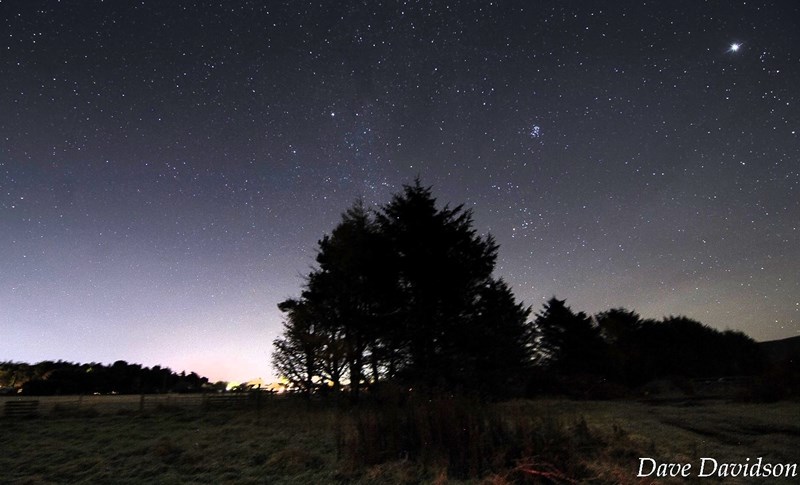
It is completely dark now and our telescopes have been set up and aligned with the Pole Star, ready to search the heavens. Tonight we have Paul (of course), Pauline, Carl, Kristina and a couple from Australia who had come to see the Northern Lights. Pauline gave the couple a tour of the Observatory and a brief explanation of what the Northern Lights are before they got fed up waiting for them to appear and left for warmer surroundings. (They should have stayed(!), as you will see in a minute). Paul and Carl were concentrating on the planets, Jupiter, Saturn, Uranus and Neptune; yes Neptune! Not much to see here and almost impossible to find, but of course Paul has a computer controlled telescope and that takes the uncertainty out of what you are looking at; the tiny dot in the centre of the eyepiece is Neptune, if that's what the keypad says! Paul was using 'bino viewers' for looking at Saturn and I have to say that when the seeing was clear, the planet was just jumping out of the field of view! You could easily see bands on the surface and the soot-black of the shadow where the rings crossed in front of the yellow orb was so fascinating and held your attention for much longer than with a normal eyepiece. Unfortunately they are useless for stars as they cut out so much of the light, but on the planets and the Moon they are just awesome; so immersive! They were a gift from one of our members (Deanne Amos) and are at the Observatory waiting for you to try them for yourself. The Moon is something else with 'bino viewers'! This is the kind of view you might get!
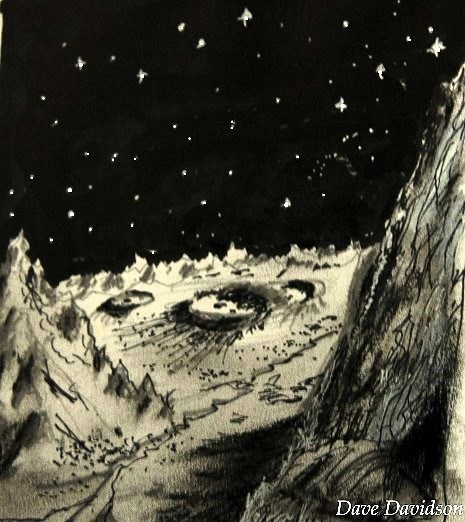
Kristina and I set about finding double stars with the 12 inch telescope and this was so much fun! Some double stars are so close that they are sometimes hard to separate but when you do, the reaction of someone who has never seen these jewels of the night is heartwarming! Kristina squealed with pure delight as each new pair became visible! Why they are so appealing I do not know but what is indisputable is that the same response is illicited in every case. Some examples would be Mesarthim (gamma Aries), v Draconis, gamma Delphinus and of course the sheer joy of Alberio in Cygnus. There are hundreds more and if you are interested in seeking them out then the 'Cambridge double star atlas' will be your best friend. We continued our quest for ages until we were stopped in our tracks by the rising Moon. Here was beauty truly blent! From the Eastern horizon and behind the distant fir trees came the glowing peach coloured Moon. Slowly and silently emerging from the blackness it threw a pale but warming halo of nebulus pink into the sky. Moon-struck, we just stared in wonder. Gradually the ochre pink turned to gold as the Moon got higher and then, bright-tipped frosted bushes and twigs winked out of the shadows like tiny fire-flies. The rising of the Moon may be an everyday occurrence and pass without note from the hectic world of the city but here in Arcadia it becomes a mystical and transcending experience. A timeless connection to the natural world and the vast symmetry of the cosmic realm.
We were awakened from our reverie when Carl called over, alerting us to an aurora borealis forming in the North! As we cast our gaze toward where he was pointing, the first green spires began to tower up into the night! Suddenly, and despite the Moon, the sky turned from gold to green and red. From within the gossamer haze near the horizon ghostly shapes waved and curled in a slow dance and ever and again a bright shaft of intense luminous light would reach up to the zenith drawing screams of delight and wonder from us all! If only our Australian visitors had waited! But it is ever thus with aurora; you wait for hours and nothing happens, then from nowhere comes a light-show that is life-changing in its splendour. Just ask Lisa(!) the most patient of hunters! The aurora did not last long though and as it faded away we turned to the South East to see another 'hunter' ..... the giant constellation of Orion peering out from behind the big tree next to the Observatory.
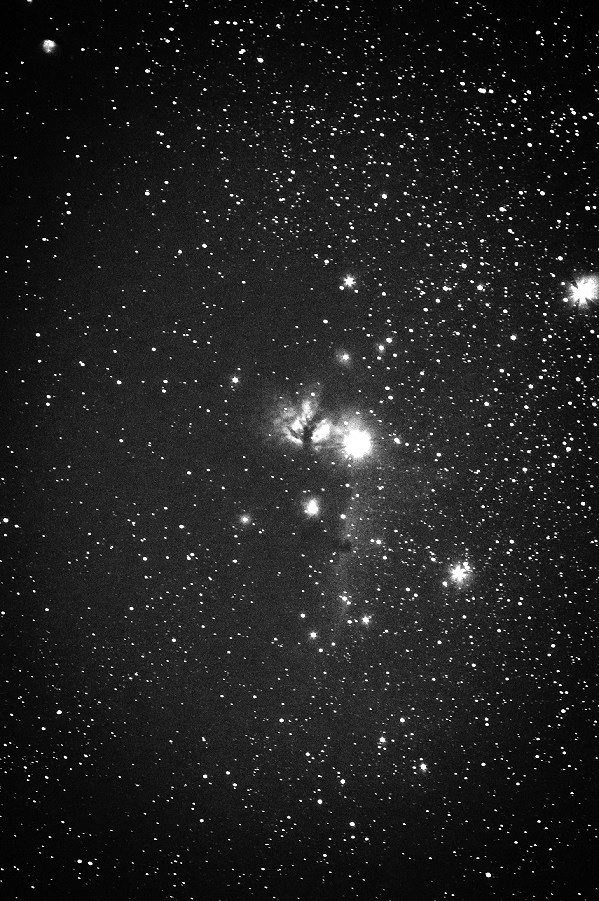
The fascination with Orion is universal and thousands of years old. As amateur astronomers we long for the nights in winter when the constellation dominates the southern sky. We are drawn to it like no other thing in the night sky and more than anything, the 3 stars of the 'belt'. Only truly revealed by a photograph, the enigmatic Horse's Head nebula hangs down from the star called Alnitak which itself is crowned by the Flame nebula. The most elaborate star patterns abound here too; doubles, triples and multiple groups everywhere. So why are the 3 stars and the pattern they form so important? Well, of course, I have no idea but it is strange that thousands of years ago our ancient 'ancestors' thought so and went to extraordinary lengths to draw attention to them. All across the globe the pattern is represented on the ground. Just take a look at these megalithic structures. How did they communicate this around the world for one thing, and consider the scale and purpose? Even just across the fields from our Observatory is the Clava Stones laid out to mirror the stars in Orion. Thornbrough Henge in Yorkshire is the same, just bigger......much bigger! China, Mexico, Egypt and there are more, all depicting the belt of Orion. It might be an interesting exersise to visit the Clava stones with our 'astronomy' hats on!
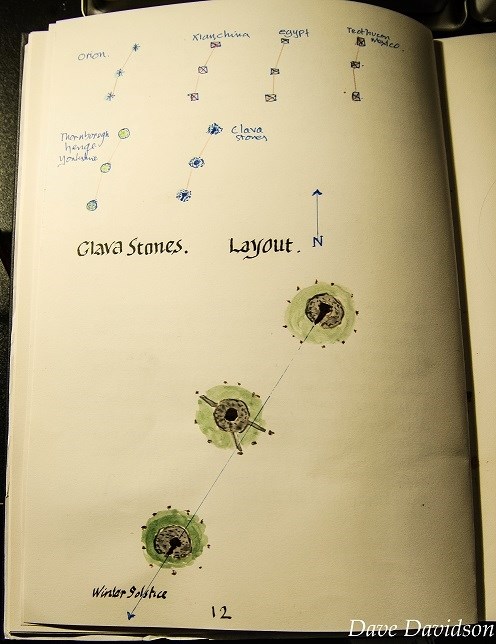
So we continued for a while longer but we were all feeling the effects of the cold and when I say cold I mean COLD! It was down to minus 10 and the telescopes were starting to freeze over making it difficult to keep observing. It was time to go home. It had been a magical night. We had seen many truly wonderful things and all the while we were there, nothing in the other world of the everyday mattered. We were absorbed entirely in our adventure into Arcadia and had touched, if only for a moment, that golden age when nature and humanity merge and the true reality of the universe is revealed.
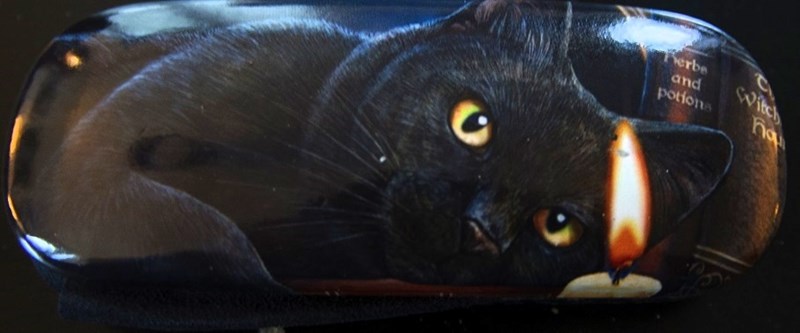
Saturday the 2nd of December 2023.
Two clear nights in a row! I pinched myself hard at tea-time just to make sure it was not a dream, but no, sure enough it was real and in no time flat I was off to Culloden and the Observatory. Guess who was already there when I arrived? Yes it is a rhetorical question, Paul Moffett is always there. Even if there was only one star to see amid an ocean of clouds then Paul would be there to view it with his telescope! He is an astronomical phenomenon. I thought I was bad but he takes the coconut everytime. Soon after we had exhanged greetings our fellow astronomers started to arrive. Eric, Gerry, Warwick with his 6 year old daughter, and Stuart and his wife. Stuart had brought with him a new telescope and I set about helping him get it working. This telescope is the Celestron Omni 102mm which is on offer at COSTCO's just now for £189.00. Comes with tripod, slow-motion controls and eyepieces. We soon had the rings of Saturn in the field of view which brought forth the customary 'Wow's' followed by the sword handle in Perseus, M36 in Auriga, and the giant nebula of M31 in Andromeda. Deeming this to be a success I left Stuart et al to pursue their own journey around the sky. Eric and Paul were outside the compound on the 'grassy square' with their telescopes. The amount of wires, red lights, batteries, glowing keypads and tables littered with eyepieces surrounding their whirring tripods looked like a fairground for gnomes! These guys are serious when it comes to searching out the faint and the far. The 'faint and far' tonight was to be NGC7331 and the adjoining Stephan's quintet. Whether we ever really saw the quintet is moot. NGC7331 we all found without much difficulty, even star-hopping with the 12 inch dobbin but the wee group of nebulas nearby was another matter. In the end we convinced ourselves that we could see them so we 'bagged' them anyway. I was less persuaded I have to say, but so be it, that box has been ticked.
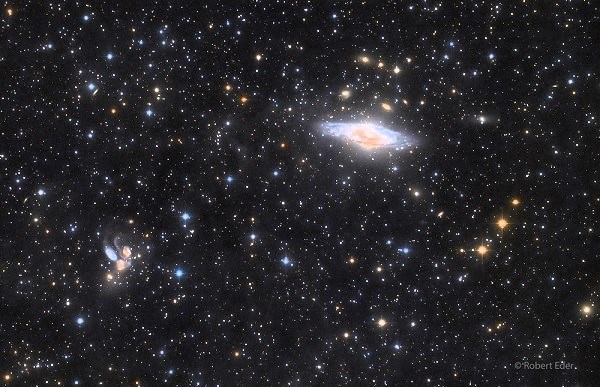
Poor Warwick's daughter very soon succumbed to the bitter cold of the night and they had to go home but next time we will try and have more time to help him get his telescope set up and working.
Gerry had set up his telescope near to the 'funfair' but actually spent more time in the 'warm room' sorting out eyepieces into boxes? It was very cold though, so who could blame him!
The sky was just filled with stars tonight as the Moon would be late in rising and the air was still and frosty. The wide ribbon of the Milky Way stretched across the void like a luminous veil drifting in a river of ink. Sometimes it is more wonderous to step back from the telescope and stare up at the gulf of space in awe at the majesty and immensity of the heavens. What is going on out there? Who else is out there? How did it get there? Alas, the inscrutible universe provides no answers, only wild guesses.
For a while we had to go into the warm office to defrost our bones, have a cup of coffee and de-brief our efforts from outside. This is a valuable time spent together recounting what we have seen, what best to use to see things and make plans for later or future ventures. Time too for discussing our own projects and research. Things like the enigma of the shadows on the Moon craters, the 'central' star in the Ring nebula, 2,570 light years away, and the size of the Earth?? and something that Paul and I have been looking into..... ' Olber's paradox' (or why is the sky dark at night?).
Fascinating stuff.
Back outside again we concluded the night with a long look at the spectacle of M42 or the great Orion nebula! There must be more photographs of this wonder of the winter skies than almost any other thing and yet for all the fancy pictures, the view through a telescope takes it to a new dimension! It simply takes your breath away. The unfathomable depths of the dark areas set against the glowing threads and curling fronds of the nebulus bit draws you into a luminous grotto filled with sparkling stars! Just amazing and never, ever fails to delight the eye.
So there we are. Reluctantly, as always, we had to pack up and go home as it was cold and late. The 'gnomes' put away their tents, locked up the Observatory and said their goodbyes. It had been another wonderful night under the stars; made all the more wonderful by the company of friends and like-minded companions.